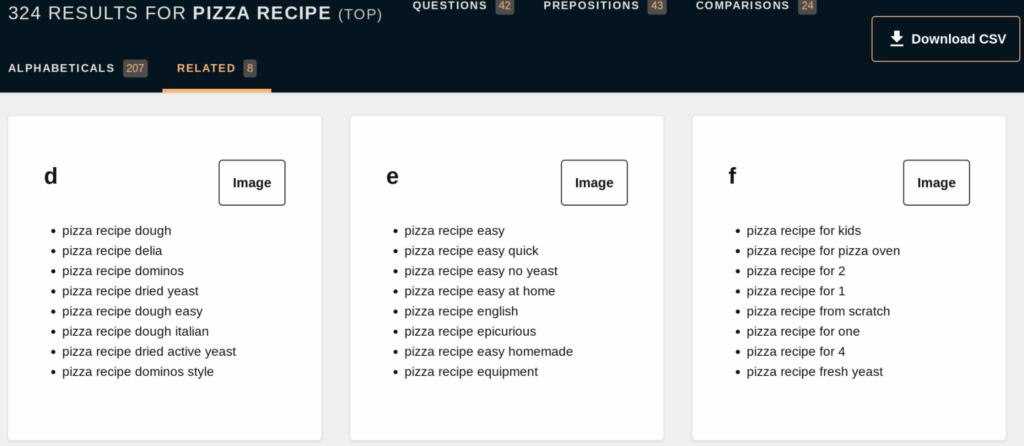Want more eyes on your food blog?
SEO is essential for food bloggers looking to increase their visibility and attract more readers. With millions of recipes available online, proper SEO techniques can help your content stand out in search results. Effective SEO can lead to:
- Higher search engine rankings
- Increased organic traffic
- Better user engagement
- More opportunities for monetization
With that in mind, we’re here to guide you through strategies to help you boost your recipes’ visibility in search results, attract more readers, and cook up success online.
Let’s dig into the meat of food blog SEO and turn up the heat on your online presence!
1. Keyword Research for Food Blogs
Effective keyword research is the foundation of any successful SEO strategy for food blogs. Understanding what your audience is searching for and how they’re phrasing their queries will allow you to tailor your content to meet their needs.
Let’s explore two key aspects of keyword research for food bloggers:
Finding Recipe-Specific Keywords
Start with your recipe ideas and expand from there.
One of the easiest ways to find what people search for is to enter a term into Google’s search bar and see what related suggestions it comes up with.

If you want to take your food blog keyword research beyond the basics, try free tools like Google’s Keyword Planner or AnswerThePublic to discover related terms and questions people are asking.
For example, keyword suggestions for ‘pizza recipe’ from AnswerThePublic include ‘pizza recipe dough’, ‘pizza recipe dominos’, and ‘pizza recipe for 2’
These topics can be split into separate pieces of content that focus on the search intent behind them, which you can identify from the search engine results page (SERP) that appears up when you search the term.
For example, if you’re targeting “pizza dough recipe”, the search intent is to find a beginner-friendly homemade dough recipe.

Whereas the search intent for “pizza recipes dominos” is, you guessed it, pizza recipes that taste like a Dominos pizza.

The two demand very different types of content.
Using Long-Tail Keywords for Culinary Niches
Don’t only target keywords with the highest search volume. These are often more competitive and may lack relevance to your audience’s niche. Instead, look for long-tail keywords – longer, more specific phrases that have less competition.
For example, if you’re planning a post on “chocolate chip cookies,” you might find related keywords like “chewy chocolate chip cookies” or “vegan chocolate chip cookies” easier to rank for than “chocolate chip cookies.”

2. On-Page SEO for Food Blog Posts
On-page SEO is crucial for helping search engines understand your content and rank it appropriately. For food bloggers, this means optimizing various elements of your recipe posts to improve visibility in search results. Here are three key areas to focus on:
Optimizing Recipe Titles and Headings
Ensure your recipe title includes your main keyword. Use H2 and H3 tags for sections like “Ingredients”, “Instructions”, and “Tips”. Don’t pepper your content with too many H2s, though, and don’t stuff keywords into H2s (that’s called over-optimizing).
Crafting SEO-Friendly URLs and Meta Descriptions
Create short, keyword-rich URLs for your recipes. Write compelling meta descriptions that include your target keyword and entice users to click. The length of a meta description shouldn’t exceed 156 characters.
Including Keywords Throughout Your Post
Naturally integrate your keywords into your content, including:
- Introduction
- Recipe description
- Cooking tips
- Ingredient alternatives
- Serving suggestions
Remember, this isn’t a game of hide-and-seek; you’re not trying to sneak your keywords into every nook and cranny. Moderation is key. Your writing should still sound like it’s written for people, not search engines.
3. Recipe Optimization Techniques
Recipe optimization goes beyond basic on-page SEO. It involves using specific techniques and tools to make your recipes more visible and appealing in search results. Let’s dive into three essential strategies for recipe optimization:
Implementing Recipe Schema Markup
Schema markup is a type of structured data that helps search engines better understand the content on your website. For recipe schema, it’s like providing a standardized “recipe card” that search engines can read and interpret. This structured data includes information like ingredients, cooking time, nutritional information, and more.
Use a recipe plugin like WP Recipe Maker to automatically apply structured data to your recipes. This helps search engines understand your content and can lead to rich snippets in search results. As a result, your recipes have a much better chance to appear as a recipe card snippet on Google.
Optimizing Recipe Instructions and Ingredients Lists
Properly optimized recipe instructions and ingredient lists are crucial for both user experience and SEO. Here’s how to make your recipes shine in search results and delight your readers:
- Write clear, step-by-step instructions
- Break down the cooking process into manageable steps
- Use numbered lists for easy following
- Start each step with an action verb (e.g., “Preheat,” “Chop,” “Simmer”)
- Include specific details like temperatures and cooking times
- Provide accurate measurements for ingredients
- Use standard measurements (cups, tablespoons, grams, etc.)
- Offer both volume and weight measurements when possible
- List ingredients in the order they’re used in the recipe
- Be thorough and complete
- Include prep time, cook time, and total time
- Specify the number of servings or yield
- Mention any special equipment needed
- Add notes for possible substitutions or variations
- Optimize for featured snippets
- Structure your content in a way that directly answers common questions
- Use clear headings for different sections (e.g., “Ingredients,” “Instructions,” “Tips”)
- Consider adding a brief summary of key steps at the beginning
- Leverage recipe structured data
- Fill out all relevant fields in your recipe card plugin
- Include details like course, cuisine, keywords, and dietary information
- Ensure correct recipe attribution if adapting from another source
- Enhance user experience
- Add tips for success or common pitfalls to avoid
- Include storage instructions or leftover ideas
- Consider adding a printable version of the recipe
While entering all this information into a recipe card plugin can be time-consuming, it’s a crucial investment in your food blog’s success. Complete and well-structured recipe data helps search engines understand and showcase your content, potentially leading to:
- Higher rankings in recipe-related searches
- Increased chances of appearing in featured snippets or recipe carousels
- Better user engagement and time spent on the page
- Improved credibility and authority in your culinary niche
Remember, thoroughness pays off in the long run. By providing comprehensive, well-organized recipe information, you’re not only helping your readers create successful dishes but also setting your food blog up for SEO success.
Earning and Displaying Recipe Ratings
To be eligible to earn star ratings for recipes, you must use a recipe card plugin. Recipe star ratings are an excellent form of social proof and give readers confidence that your recipe is a winner. Star ratings also help a recipe stand out in the search results.
Don’t be shy – ask readers to leave star ratings for your recipes (but do not incentivize readers to give recipe reviews). Also regularly test to make sure that a star rating is easy to leave for a recipe.
4. Image and Video SEO for Food Content
Visual content is a cornerstone of food blogging, but it’s not just about making your dishes look delicious. Properly optimizing your images and videos can significantly boost your SEO efforts. Here’s how to make your visual content work harder for your food blog:
Optimizing Food Photography for Search Engines
Visual content is vital for food blogs. You need to know how to make them meaningful for search engines so they can count them when calculating the value of your content. Here’s how:
- Use descriptive, keyword-rich file names for your images
- Add alt text that accurately describes the image and includes relevant keywords
- Compress images to improve page load speed
An effective alt text should be less than 125 characters and should incorporate your target keyword in a seamless manner. It should also describe the image as it is. For example, “Cookie batter in a mixer. Vegan chocolate chip cookie recipe” is a bad example of an alt text. A better example would be: “Vegan chocolate chip cookie batter in the mixer.”
Leveraging Video Content for Recipe SEO
If you create video content, host it on platforms like YouTube and embed it in your blog post. Optimize video titles, descriptions, and tags with relevant keywords. Don’t upload your recipe videos to your website; use YouTube to host them to help with site speed.
5. Technical SEO for Food Blogs
While creating great content is crucial, the technical aspects of your food blog play a vital role in how search engines crawl and rank your site. Let’s explore some key technical SEO considerations for food bloggers:
Improving Site Speed and Core Web Vitals
Site speed is another vital ranking factor. Use a tool like Pingdom Website Speed Test to check the page speed of your recipe pages/posts. To improve site speed:
- Use a fast, reliable web host
- Optimize and compress images
- Minimize plugins and remove unused ones
- Consider using a caching plugin like WP Rocket
- Work with only lightweight plugins like WP Recipe Maker that are optimized for speed to power your recipes
Mobile Optimization for Recipe Websites
You can’t overlook the importance of mobile devices when optimizing SEO. To see where you stand, try Google’s Mobile-Friendly Test. If you are using a responsive theme design, compress image sizes, and use plugins like WP Recipe Maker that have built-in mobile optimization features, your mobile friendliness score should come up quite high.
Creating an SEO-Friendly Site Structure
Organize your recipes into clear categories and use a logical URL structure. This helps both users and search engines navigate your site easily. A site with a great category structure improves dwell time and pages per session if your internal linking strategy is strong. Also, the better your category structure, the easier Google can access, crawl, and index your content.
6. Building Authority in the Food Blogging Space
Establishing your food blog as an authoritative source is crucial for long-term SEO success. It’s about more than just creating great recipes; it’s about building trust with both your audience and search engines. Here are two key strategies to boost your blog’s authority:
Creating High-Quality, Trustworthy Recipe Content
Focus on creating thorough, well-tested recipes with clear instructions. Provide valuable information about ingredients, techniques, and variations to establish your expertise. Practice measurements, clear instructions, and helpful tips demonstrate your expertise and reflect your confidence and experience.
Earning Backlinks from Reputable Culinary Sites
Building authority is like slow-cooking your favorite comfort meal – it takes time, patience, and a solid recipe. Here are some ways to build it:
- Guest posting: Write for other reputable food blogs or websites. Secure a backlink to your blog or a specific post.
- Quality content: Write helpful, well-researched, and unique content. The more your content helps readers, the more Google will favor you.
- Getting backlinks: The more backlinks you earn from reputable sites, the higher your authority.
- Social proof: Just as we love reading reviews before trying out new eateries, your blog visitors love to see genuine testimonials.
7. Content Strategy for Food Blogs
A well-planned content strategy can significantly boost your food blog’s SEO performance. By organizing your content thoughtfully and planning ahead, you can create a more cohesive user experience and improve your search rankings. Let’s look at two powerful content strategies:
Developing Recipe Clusters and Topic Hubs
A recipe cluster is when you combine your related recipes for a more significant SEO impact. Basically, think of it like a cuisine section on your website. You may have 10 recipes related to Mediterranean cuisine, which all help form your Mediterranean cluster.
To build a powerful recipe cluster:
- Choose a theme: Let’s say you cover Mexican food. Your recipe cluster could be “Mexican Dishes You Can Make at Home.”
- Select related recipes: Rally together all your enchilada, taco, and salsa recipes. Now, start grouping the ones that fit your theme.
- Link between the recipes: Within your posts, add links to other recipes in your cluster. This is how you start helping readers and search engines find your related content.
- Present them as a group: Create a new blog post or page for the complete cluster, listing all recipes included in it.
Planning Seasonal and Trending Recipe Content
Stay ahead of food trends and seasonal ingredients. Use tools like Google Trends to identify popular recipe searches throughout the year and plan your content accordingly. Developing a content plan for your posts will help you maintain a steady flow of new content and will allow you to prepare for seasonal trends.
8. Using SEO Tools for Food Blogs
The right tools can make a world of difference in your SEO efforts. From analyzing your performance to optimizing your content, these tools provide invaluable insights and capabilities. Here are some essential SEO tools for food bloggers:
Leveraging Google Search Console and Analytics
Google Search Console and Google Analytics are two must-use tools. Sign up for both of these tools right away. They’re leaned on heavily for SEO strategy.
In Google Search Console, go to Index > Sitemap and submit your food blog’s sitemap. You can also monitor how your blog performs in search results. Pay particular attention to elements like queries, clicks, impressions, and clickthrough rate (CTR).
Google Analytics breaks down what people are doing on your site. How long are they spending on a page? What percentage of visitors leave your site quickly (bounce)? And what pages are most popular?
Recommended SEO Plugins for Food Bloggers
In addition to recipe card plugins, consider using:
- ShortPixel for image compression
- WP Rocket for caching and speed optimization
While tools like Yoast SEO are particularly popular in the SEO industry, we’d advise not relying too much on this tool, as its traffic light system can be misleading. It’s very easy to create a piece of content that checks all of Yoast’s criteria but doesn’t meet the search intent and, therefore, doesn’t rank well.
In our opinion, you’re far better off using an all-in-one recipe and SEO plugin for your food blog, such as WP Recipe Maker.
9. Advanced SEO Strategies for Food Blogs
Once you’ve mastered the basics, it’s time to explore more advanced SEO strategies. These techniques can help you stay ahead of the competition and capture more targeted traffic. Let’s dive into two advanced strategies for food bloggers:
Conducting Competitor Analysis in the Food Niche
Study successful food blogs in your niche to understand their content strategy, keyword usage, and backlink profiles. Use this information to inform your own SEO strategy. Here’s how to conduct an effective competitor analysis:
- Identify your main competitors
- Analyze their content:
- Structure
- Recipe formats
- Posting frequency
- Most popular posts
- Research their keywords:
- Use tools like SEMrush or Ahrefs
- Identify which keywords they’re ranking for
- Examine their backlink profiles:
- Find out which websites are linking to them
- Discover potential partnership opportunities
- Understand which content types attract valuable backlinks
Optimizing for Voice Search and Featured Snippets
Structure your content to answer common questions related to your recipes. Use clear, concise language that’s optimized for voice search queries. This can help your content appear in featured snippets and voice search results.
10. Measuring and Improving Your Food Blog’s SEO Performance
Regularly review your SEO performance using tools like Google Analytics and Search Console. Identify top-performing recipes and pages, and use these insights to refine your strategy.
Watch the clickthrough rate of top posts. Improving the clickthrough rate of a recipe post or article by even a percentage point or two has the potential to significantly boost organic traffic over time.
Remember, SEO is an ongoing process: If your keyword rankings start to drop over time, schedule the content for some maintenance to keep it fresh.
Staying up-to-date with the latest trends and algorithm changes can provide context to changes in your performance. Being aware of when Google’s core updates are rolled out will allow you to understand if your keyword rankings are fluctuating in the short term due to an update.
Create a Winning Food Blog SEO Strategy Today
Mastering food blog SEO doesn’t have to be a complex recipe. By focusing on quality content, understanding your audience, and implementing technical best practices, you’re already on the path to higher rankings.
To improve your food blog’s SEO effortlessly, leverage tools tailored for food bloggers. WP Recipe Maker stands out by automatically tackling crucial SEO tasks, from implementing schema markup to perfecting mobile optimization. It’s like having a dedicated SEO expert working behind the scenes while you focus on what you do best: crafting mouthwatering recipes that keep readers coming back for more. It’s the perfect blend of SEO power and user-friendly features, helping your recipes reach more hungry readers. Get a head start with your food blog’s SEO with WP Recipe Maker – a lightweight WordPress recipe plugin that turbocharges your recipes with the best SEO practices so they rank well.
a








Hi, thank you! This is so informative.
This is helping so much! I’ve been blogging for 6 years and I feel like it’s going nowhere… literally! This helps! Thank you!
Excellent Post topic and content. Was very helpful. Started 3 months ago and getting ready to make more structure changes.